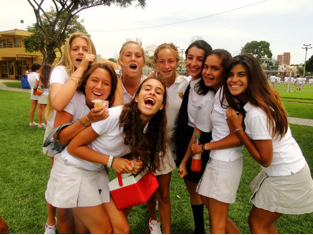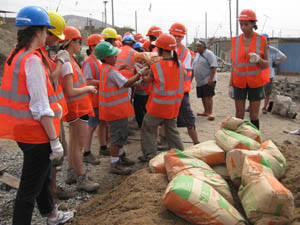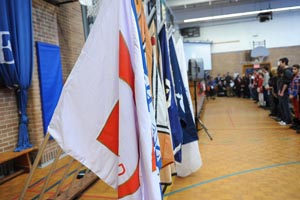 There we were, a group of 21 students on a four-hour bus ride awaiting our camping destination. For most of us, the Salkantay trail possessed both wonder and a sense of “je ne sais quoi” as we, teenagers from Canada, would be trekking through the Andes of Peru, a place foreign to all of us. Many of us were excited to start the hiking part of the journey after completing a week of community service in Las Palmas, which although extremely rewarding, was also quite dirty. Of course, the definition of “dirty” was changed along with our experiences on this trip. Dirty was no longer food stuck in one’s teeth, dirty now qualified as not having showered for four days and having mud caked on one’s face. As we arrived at our campsite, we were faced with a breathtaking mountain, with snow adorning its peak. Our tents had already been set up by the wonderful, and most helpful, crew of native Peruvians, all who accompanied us on our trek. In a way, the crew was like our shadow, meeting us at the destination to set up our tents and prepare us food, well before we all arrived, and then waking us up early in the morning to serve us “cocoa tea,” a Peruvian favourite.
There we were, a group of 21 students on a four-hour bus ride awaiting our camping destination. For most of us, the Salkantay trail possessed both wonder and a sense of “je ne sais quoi” as we, teenagers from Canada, would be trekking through the Andes of Peru, a place foreign to all of us. Many of us were excited to start the hiking part of the journey after completing a week of community service in Las Palmas, which although extremely rewarding, was also quite dirty. Of course, the definition of “dirty” was changed along with our experiences on this trip. Dirty was no longer food stuck in one’s teeth, dirty now qualified as not having showered for four days and having mud caked on one’s face. As we arrived at our campsite, we were faced with a breathtaking mountain, with snow adorning its peak. Our tents had already been set up by the wonderful, and most helpful, crew of native Peruvians, all who accompanied us on our trek. In a way, the crew was like our shadow, meeting us at the destination to set up our tents and prepare us food, well before we all arrived, and then waking us up early in the morning to serve us “cocoa tea,” a Peruvian favourite.
As the first morning of our trek began, the sun illuminated the snow surrounding us, creating a picture-perfect moment. We were all excited to begin our journey, not phased with the cold we were so used to back home. We marched together as a united force for a while, until we started to reach steep inclines. Then our group seemed to separate into three, those strong ones at the front, those in the middle, and those who were in the back of the group. Being a part of the “back group,” I am proud to say that there is no shame involved in falling behind. The teachers always made it clear to go at our own pace and not to push ourselves too much. In a way, being in the back gave me a chance to connect with different people, whether it was by telling stories, playing games such as the all too popular “Ghost,” or by our collective determination to reach the top. It was a very proud moment when our group reached the top, as we placed the stones we had picked up at the bottom of the mountain, and placed them on top of each other, a ritual designed to respect Pachamama. Pachamama is what the Peruvians call Mother Earth, she allows for some to have a safe journey through the mountains. It seems that on this particular day, Pachamama was irritated as we were walking through freezing rain for the better part of the day. However, the rain finally stopped and we all made it back to our campsite, whether on foot or on emergency mule.
The next early morning, we all groaned at the prospect of climbing steep inclines yet again. However, our group leader, Julie, who was extremely kind and helpful, informed us that today would be mostly flat, with very few inclines. True to her promise, the second day of hiking was probably the most enjoyable. The sun was out, there was a nice pool of water that we could dunk our feet into during a rest, and for the most part, the group was united. Also, the last leg of the day was spent walking through a small Peruvian village. During the walk in the village, we got a small taste of Peruvian life as we got to witness young children coming home from the local school and also see the local equivalents of depanneurs, which were surrounded by chickens. Stopping at one of the depanneurs to buy Doritos, I realized that munching on something so familiar made me happy to be away from home. We were all experiencing something new; we were a part of something eye- opening and bigger than 21 students put together. We all realized this, and we all wanted in.
Finally, the last day of our hike arrived. Most of us were tired from the long trek the day before and from the sounds of two dogs barking endlessly into the night, waking everybody up. Yes, the morning of today’s hike would be difficult, as we were walking up a very steep incline and then walking down a very steep decline. Honestly, walking up that hill was probably one of the most physically exhausting things many of us have ever done. I could hear the sounds of tears, cursing and heavy breathing as we all fumbled up the jungle path. What seemed to go on forever soon ended, as we were greeted by a high-five from Yuri, another animated group leader of ours, as he congratulated us for finishing the hardest part.
After the morning hill, we spent the rest of the day hiking through what seemed to be a jungle, as there was plant and insect life all around us. Tiptoeing through large red-footed millipedes and equally large green caterpillars, we finally made it down to flat land. With our feet hurting and our legs buckling under us, we walked through a construction zone and past an extremely large waterfall, which seemed to be the source of the large river to our left. My friend and I momentarily stopped near the waterfall to feel its mist surrounding our bodies, which was extremely refreshing. The smell of mint filled the air, as there was wild mint growing in the area. Finally, after walking for a while longer, we met up with the rest of the group who was enjoying lunch. After finishing my soup and as I was about to dig into my main course, the teachers informed us that we had a choice: either we walk another 10km to the campsite, or we take the train immediately. All of us, except for two strong souls, not leapt but bounded at the opportunity to ride the train. Scarfing down my meal in record time, we boarded the train and relaxed during the 20-minute ride. We had finished our trek, and Macchu Picchu lay just around the corner. That night was spent celebrating as we all high fived each other and gave each other knowing smiles. Yes, we Montrealers had done it; we had completed the Salkantay trail!
Looking back, I’m proud that we all had the courage and strength to pull through. Not only am I proud of us as a group, I’m also proud of how we all came through as individuals during the trek. In a way, the best of everyone’s individual traits shone through, which not only made for a strong group, but for very good company during the hike as well. Although it was difficult—very difficult at times—if I had the chance to do it again, you bet I would. —Isabelle Thibault ’11
 As I sat on the airplane leaving Montreal, I had no idea what to expect. Peru was completely unknown to me. Although, I was extremely nervous, I was ready to embrace the six-week adventure that stood before me. I have been here for about two weeks now and I can honestly say I’m having the time of my life.
As I sat on the airplane leaving Montreal, I had no idea what to expect. Peru was completely unknown to me. Although, I was extremely nervous, I was ready to embrace the six-week adventure that stood before me. I have been here for about two weeks now and I can honestly say I’m having the time of my life. 



